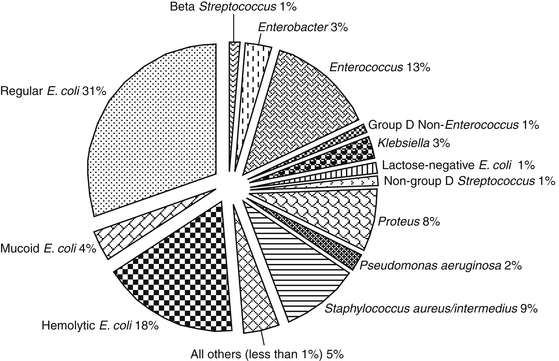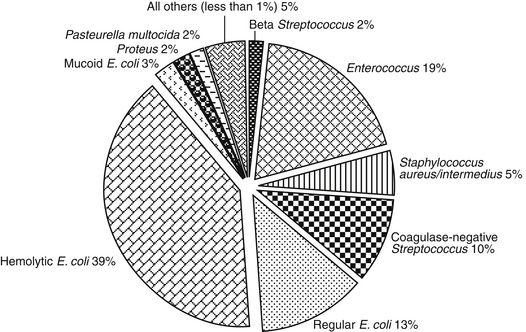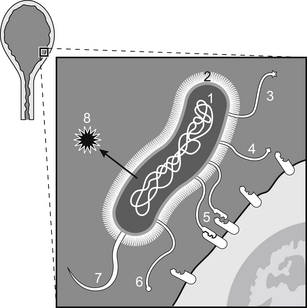Chapter 8 Cystitis and Urethritis
Urinary Tract Infection
Introduction
A. Urinary tract infection (UTI) is defined as bacterial colonization of portions of the urinary tract that normally are sterile (i.e., kidneys, ureters, bladder, proximal urethra).
1. UTI can occur superficially on luminal surfaces, deeper within the parenchyma, or in both locations.
D. The term cystitis often is used to refer to bacterial UTI. The urinary bladder primarily is involved in these disorders, but the urethra may also be part of the process. Cystourethritis may be a better term.
1. It is difficult to assess the involvement of the urethra in UTI because of limitations of the commonly used diagnostic tests.
Pathogenesis and Pathophysiology
Bacteria Associated with Urinary Tract Infection
1. Bacteria commonly associated with urinary tract infection in dogs and cats are shown in Figures 8-1 and 8-2.
a. Most UTIs are caused by a single organism (monomicrobic). A single organism is isolated in 75% of cases, two organisms are isolated in 20%, and three organisms are isolated in 5% of UTI.
(a) Coagulase-negative Staphylococcus species can be pathogenic in the urinary tract of cats, accounting for about 20% of isolates in recent reports (Staphylococcus felis).
(i) Traditionally, coagulase-negative staphylococci have been considered contaminants. S. felis is a normal commensal organism of the skin, conjunctiva, and saliva of cats.
(ii) Most laboratories report staphylococci as “coagulase-negative” and do not further characterize as to species (which requires ribosomal RNA gene sequencing technology).
d. Breed differences.
(1) German shepherd dogs, miniature and toy poodles, Labrador retrievers, dachshunds, Doberman pinschers, and miniature Schnauzers may have increased incidence of UTI.
Normal Host Defenses Against Establishment of Urinary Tract Infection
2. Normal flora of the distal urethra, vagina, and prepuce may be protective. Normal flora may occupy uroepithelial receptors and consume micronutrients, preventing pathogenic bacteria from establishing an infection.
3. Urine from healthy animals inhibits the growth of bacteria.
b. High urine osmolality inhibits bacterial growth. This mechanism may be particularly important in cats.
4. Host defense mechanisms exist for the perineum, vagina, prepuce, urethra, bladder, ureters, renal pelvis, and renal parenchyma.
b. Urethral host defense mechanisms.
(1) Epithelial cells lining the urethra (i.e., urothelium) can physically trap bacteria and bar their ascent.
(2) The mid-urethra has a functionally important high-pressure zone that helps prevent bacterial ascension.
(3) Urethral length, width, and distance from anus.
(a) The female urethra is wider and shorter than the male urethra, conceivably making it easier for bacteria to ascend into the bladder. Since the anus is closer to the urethral orifice of female dogs than males, there is a greater chance of fecal contamination and inoculation of organisms for female dogs. Male dogs may have additional protective mechanisms due to antibacterial prostatic secretions.
(2) Normal glycosaminoglycans (GAG) on the uroepithelium inhibit attachment of bacteria (antiadherence properties).
(3) Bladder urothelium has some inherent bactericidal properties, but bacteria must be in close apposition for this effect to be valuable.
d. Ureters.
(1) The distal movement of urine (i.e., from kidney to bladder) inhibits ascent of bacteria. However bacteria in the ureters can ascend by Brownian motion against the flow of urine.
Increased Risk for Development of Urinary Tract Infection
1. Anatomic abnormalities of the genitourinary system (Boxes 8-1 and 8-2).
a. Urachal remnants may provide a reservoir of stagnant urine, have decreased GAG, and be associated with microabscesses.
b. Ectopic ureters.
(2) Higher incidence in Siberian huskies, toy and miniature poodles, golden retrievers, Labrador retrievers, fox terriers, West Highland white terriers, collies, soft coated Wheaten terriers, and Welsh corgis.
(4) Most ectopic ureters terminate in the urethra of females and may allow vaginal bacteria to ascend the ureter into the kidney.
BOX 8-1 ANATOMIC AND FUNCTIONAL ABNORMALITIES PREDISPOSING TO OR PRERPETUATING URINARY TRACT INFECTION
2. Exogenous corticosteroid use in dogs.
b. In dogs and cats with indwelling catheters, 50% develop UTI within days, even if receiving antimicrobials.
History
Diagnosis
Urinalysis
Urine Specific Gravity (USG)
b. Dilute urine may occur in the presence of pyelonephritis or when lower UTI is associated with systemic absorption of bacterial endotoxin, which impairs the responsiveness of the collecting ducts to antidiuretic hormone.
e. Varying combinations of hematuria, pyuria, proteinuria, and bacteriuria usually are identified on urinalysis.
Pyuria
Urine Sediment
![]() Failure to visualize bacteria in urine sediment does not rule out UTI, and presence of bacteria does not necessarily mean UTI is present.
Failure to visualize bacteria in urine sediment does not rule out UTI, and presence of bacteria does not necessarily mean UTI is present.
Urine Culture
b. Plate collected urine on blood agar and MacConkey media within 15 minutes of collection.
(1) Most bacteria will grow within 18 to 24 hours at 37° C. Most veterinary isolates of Mycoplasma grow within 3 days on routine blood agar plates (unusual strains can require 7 days or longer) and special media. Corynebacterium can require up to 4 days to grow following inoculation.
< div class='tao-gold-member'>
Only gold members can continue reading. Log In or Register to continue
Stay updated, free articles. Join our Telegram channel

Full access? Get Clinical Tree





